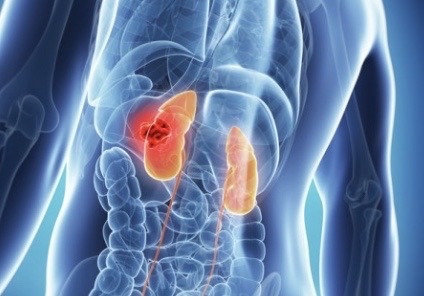 Results of Stereotactic Body Radiation Therapy for Primary Renal Cell Carcinoma in a Large Multicenter Series
Results of Stereotactic Body Radiation Therapy for Primary Renal Cell Carcinoma in a Large Multicenter Series
Conclusions and Clinical Implications: This large series of primary RCC treated with SBRT (like CyberKnife) demonstrates excellent LC and renal function preservation, and is associated with an acceptable toxicity profile. SBRT is an alternative treatment for inoperable patients.
Abstract: Background and Objective: For inoperable patients, stereotactic body radiation therapy (SBRT) is a noninvasive treatment approach for primary renal cell carcinoma (RCC). We aimed to evaluate local control (LC) of primary RCC treated with SBRT.
Methods: This multicenter retrospective study involved 16 centers in Australia, France, Italy, and the Netherlands. The primary endpoint was the LC probability, and the secondary endpoints were progression-free survival, overall survival (OS), cumulative incidence of cancer-related deaths, toxicities, and renal function evolution after SBRT.
Key Findings and Limitations: A total of 144 patients, treated between 2008 and 2020, with a median follow-up of 43 mo (interquartile range [IQR], 24.0–81.2), were included. The median age was 76 yr (IQR, 67.0–82.0) and the median tumor size was 4.4 cm (IQR, 3.3–5.6). The median baseline estimated glomerular filtration rate (eGFR) was 60 ml/min/1.73 m2. Of the patients, 40% had mild to moderate eGFR (30–60 ml/min). The two main treatment regimens were 42 Gy in three fractions and 26 Gy in one fraction. The LC probability was 98% at 1 yr (95% confidence interval [CI], 94–99) and 96% (95% CI, 92–99) at 5 yr. The median OS was 58 mo and the cumulative incidence of cancer-related deaths was 8% (95% CI, 3–15) at 5 yr. Seventy-one patients (49%) experienced at least one toxicity, including grade 1 in the majority (32%), grade 2 (14%), and grade 3 (1%). Two patients (1%) underwent dialysis (grade 4). The median eGFR loss was –7 ml/min (IQR, –17; 0) at the last follow-up.
Conclusions and Clinical Implications: This large series of primary RCC treated with SBRT demonstrates excellent LC and renal function preservation, and is associated with an acceptable toxicity profile. SBRT is an alternative treatment for inoperable patients.
Introduction: Renal cell carcinoma (RCC) affects approximately 430 000 people worldwide annually, with an increasing incidence [1]. Patients are more often elderly, with a median age of 65 yr at diagnosis [2]. Advanced age is associated with increased prevalence of comorbidities, such as cardiovascular disease, hypertension, diabetes, and chronic kidney disease, which may limit major surgery and anesthesia.
Imaging developments have led to the increased detection of renal tumors at an early stage [3]. In >80% of cases, RCC is localized at diagnosis [4]. The standard treatment for localized RCC is surgery [5].
During the past few decades, minimally invasive therapeutic options for nonsurgical patients, such as radiofrequency ablation (RFA), cryoablation, microwaves, laser, and ultrasound, have been developed [6], [7], [8]. Active surveillance (AS) can be used in patients with small tumors, with a low risk of developing metastatic disease and little benefit to surgery in older patients due to high-competing-cause mortality [9], [10], [11], [12].
RCC has long been considered a radioresistant tumor; thus, conventionally fractionated radiotherapy (1.8–2.0 Gy) was used for palliative treatment [13]. However, this historical radioresistance can be overcome by using ablative intent by means of higher doses in a fewer number of fractions [14]. Stereotactic body radiation therapy (SBRT) has emerged as a noninvasive nephron-sparing therapeutic option for inoperable RCC [15], [16]. The meta-analysis conducted by Correa et al [17], including 372 patients from 26 studies, treated with SBRT for primary RCC, suggested an excellent local control (LC) of 97.2% (95% confidence interval [CI], 93.9–99.5) with a median follow-up of 28 mo. Recently, the IROCK trial reported excellent 5-yr outcomes after SBRT for primary RCC, with a low cumulative incidence of relapse of 5.5% (95% CI, 2.8–9.5) [18].
We report here the results of one of the largest international series to date. The primary objective of the present retrospective multicenter study was to evaluate the LC of primary RCC treated with SBRT, reporting dosimetric data according to the International Commission on Radiation Units and Measurements (ICRU) report 91 [19]. The secondary objectives were to investigate survival outcomes, toxicities, and renal function (RF) evolution after SBRT.
Study Design: This was a multicenter retrospective study involving 16 centers in four countries (Australia, France, Italy, and the Netherlands). All consecutive patients who met the eligibility criteria were retrospectively included. The inclusion criteria were as follows: patients aged ≥18 yr who were treated with SBRT for RCC from 2008 to 2020 at the participating centers. Patients who underwent SBRT in nephrectomy bed or those with urothelial carcinoma were excluded. Ethical approval as per local
Baseline Characteristics: We included 144 patients from 16 centers (one in Australia, eight in France, six in Italy, and one in the Netherlands) who underwent SBRT for primary RCC from January 2008 to December 2020 (Supplementary Fig. 1). Population characteristics are presented in Table 1.
The median age at diagnosis was 76 yr (interquartile range [IQR], 67–82); 74% were men, and 80% had Eastern Cooperative Oncology Group (ECOG) performance status of 0–1. The median (IQR) eGFR at baseline was 60 ml/min/1.73 m2 (45–72).
Discussion: In our study, SBRT yielded excellent LC for primary RCC, with a cumulative incidence of local failure of 2% at 1 yr and 4% at 5 yr. To date, this is one of the largest studies on this topic. Additionally, this is the first retrospective multicenter study of RCC treated with SBRT to report dosimetric data in accordance with the ICRU 91 report [19]. The most commonly used dose fractionation regimens in our cohort—26 Gy in one fraction and 42 Gy in three fractions—are consistent with the existing
Conclusions: This retrospective multicenter study indicates that SBRT offers good LC with a low incidence of severe toxicity for primary RCC. RF preservation was acceptable, although OS was lower than in some published studies, likely due to patient age and comorbidities. While SBRT appears to be a reasonable option for inoperable patients, further prospective studies are needed to refine treatment protocols.
Here’s the link to the study in Science Direct Medical Journal: https://www.sciencedirect.com/science/article/abs/pii/S258893112500001X
The study was first published in European Urology Oncology
CyberKnife for Kidney Cancer Treatment: CyberKnife Radiosurgery is a non-surgical way to treat tumors, which should always be considered when dealing with kidney tumors. At CyberKnife Miami we have saved not only kidneys, but lives of kidney cancer patients. While surgery is often the first treatment options doctors tell patients about, they can find themselves in big trouble if they have their kidney removed and then cancer develops in the other kidney. CyberKnife radiation therapy can often save the kidney, and keep it functioning.
See Earl’s story. He was treated at the CyberKnife Center of Miami and continues to do well with both his kidneys functioning.
Here’s the link: https://www.cyberknifemiami.com/earls-story-beating-kidney-cancer-cyberknife-saving-both-kidneys/
References (34)
- U. Capitanio et al.Epidemiology of renal cell carcinoma
Eur Urol(2019) - B. Ljungberg et al.European Association of Urology guidelines on renal cell carcinoma: the 2022 update
Eur Urol(2022) - M. Sun et al.Management of localized kidney cancer: calculating cancer-specific mortality and competing risks of death for surgery and nonsurgical management
Eur Urol(2014) - G. De Meerleer et al.Radiotherapy for renal-cell carcinoma
Lancet Oncol(2014) - G. Francolini et al.Stereotactic body radiation therapy (SBRT) on renal cell carcinoma, an overview of technical aspects, biological rationale and current literature
Crit Rev Oncol Hematol(2018) - R.J.M. Correa et al.The emerging role of stereotactic ablative radiotherapy for primary renal cell carcinoma: a systematic review and meta-analysis
Eur Urol Focus(2019) - S. Siva et al.5-Year outcomes after stereotactic ablative body radiotherapy for primary renal cell carcinoma: an individual patient data meta-analysis from IROCK (the International Radiosurgery Consortium of the Kidney)
Lancet Oncol(2022) - S. Siva et al.Impact of stereotactic radiotherapy on kidney function in primary renal cell carcinoma: establishing a dose–response relationship
Radiother Oncol(2016) - M. Gaudreault et al.Reducing the impact on renal function of kidney SABR through management of respiratory motion
Phys Med(2021) - W.R. Grubb et al.Final results of a dose escalation protocol of stereotactic body radiotherapy for poor surgical candidates with localized renal cell carcinoma
Radiother Oncol(2021) - R.M. Glicksman et al.Stereotactic body radiotherapy for renal cell carcinoma: oncological and renal function outcomes
Clin Oncol(2023) - R. Castellana et al.Efficacy and safety of MWA versus RFA and CA for renal tumors: a systematic review and meta-analysis of comparison studies
Eur J Radiol(2023) - G.D. Stewart et al.The multispeciality approach to the management of localised kidney cancer
Lancet(2022) - S. Siva et al.Stereotactic ablative radiotherapy for ≥T1b primary renal cell carcinoma: a report from the International Radiosurgery Oncology Consortium for Kidney (IROCK)
Int J Radiat Oncol(2020) - P.A. Caputo et al.Cryoablation versus partial nephrectomy for clinical T1b renal tumors: a matched group comparative analysis
Eur Urol(2017) - G. Rembeyo et al.Percutaneous ablation versus robotic partial nephrectomy in the treatment of cT1b renal tumors: oncologic and functional outcomes of a propensity score-weighted analysis
Clin Genitourin Cancer(2020) - J.H. Chang et al.Stereotactic ablative body radiotherapy for primary renal cell carcinoma in non-surgical candidates: initial clinical experience
Clin Oncol(2016)
There are more references available in the full text version of this article.
Author contributions: David Pasquier had full access to all the data in the study and takes

